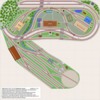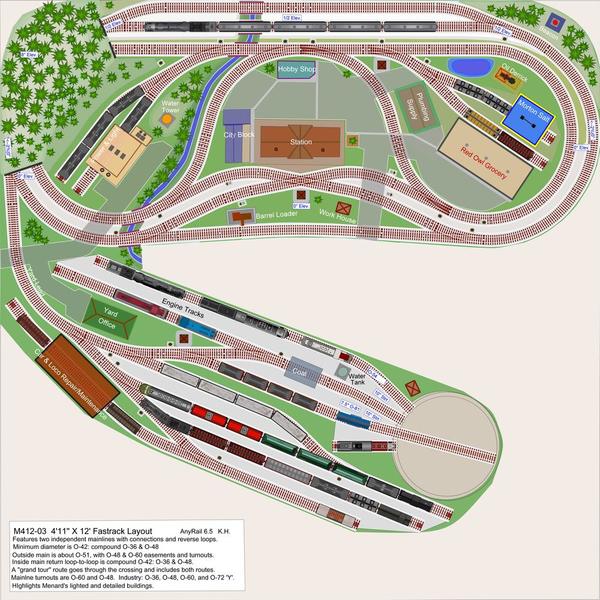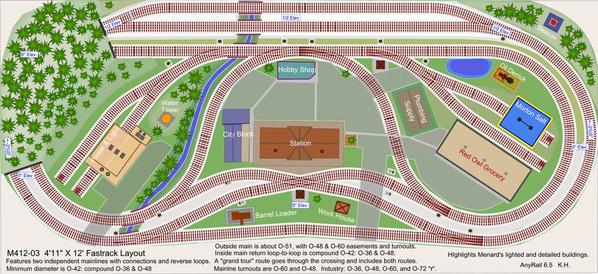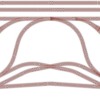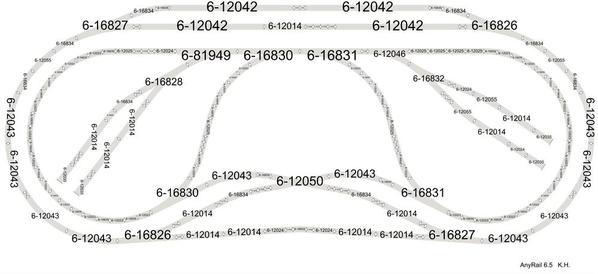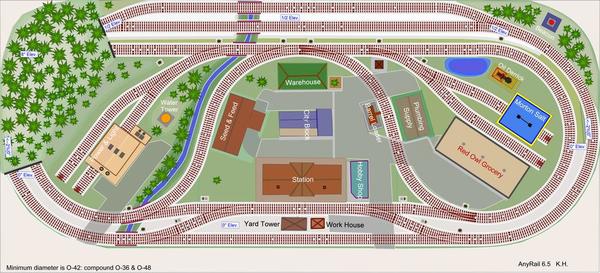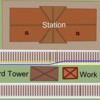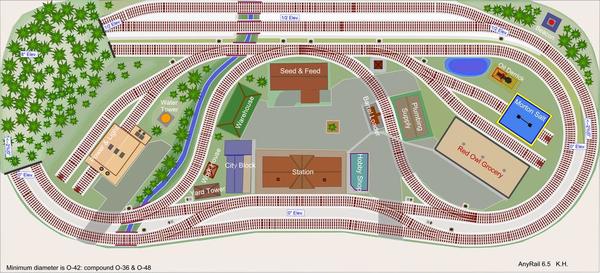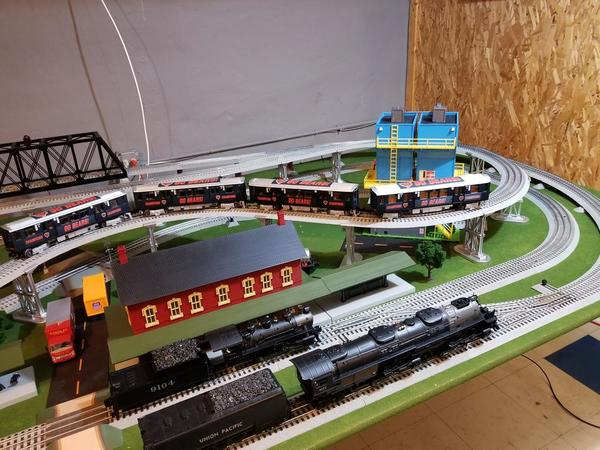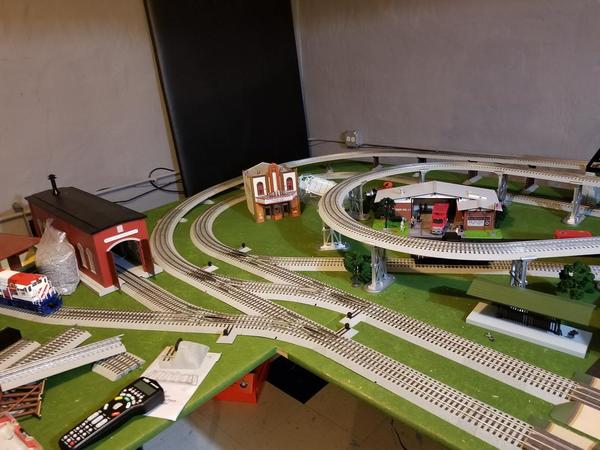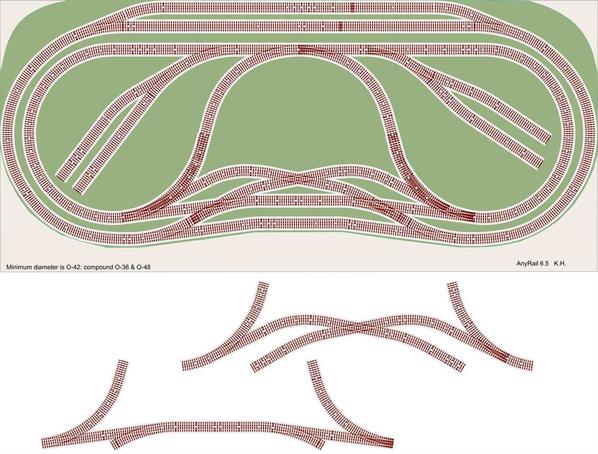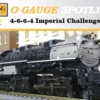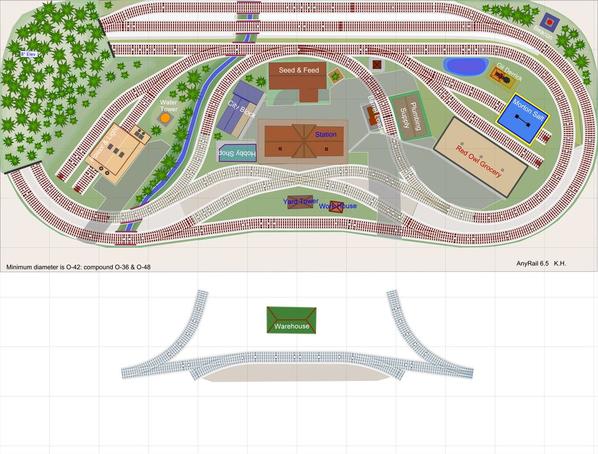In the yard area, I would be concerned about the practicality of coupling and uncoupling on a curve. Also, having a curve leading into a turntable is problematic in my experience. Just thought I'd share. Have fun.
William 1 posted:In the yard area, I would be concerned about the practicality of coupling and uncoupling on a curve. Also, having a curve leading into a turntable is problematic in my experience. Just thought I'd share. Have fun.
Ken- I agree with William1.
What if you moved the TT to the left in the corner and re-worked the yards to be more straight? A lot of my siding space is on curves and its impossible to get couplers to line up without intervention from the giant hand ![]() . Several shorter sidings might give more interest and flexibility for additional operating accessories too.
. Several shorter sidings might give more interest and flexibility for additional operating accessories too.
Bob
Thanks Bob and William! Is this an acceptable arrangement do you think? 10" of straight off the turntable, then 7.5 degree of O-81 curve.
Attachments
Attachments
Looks good Ken.
Attachments
From a brief discussion on another thread using O-72 turnouts, I was able to revise the plan to replace the four O-60 turnouts around the outside loop with O-72. This kept the length the same, but added a bit to the width. Fewer track sections are needed, so I thought this was worth posting as an update & revision.
Here is the AnyRail file for this revised track plan:
The demo version of AnyRail is free to try, and allows you to save plans with up to 50 track sections. But it will also allow you to load and view this track plan, though you cannot save any variations with the free demo.
This is the plan version that approximates O-42 using compound curves of O-48 and O-36.
Attachments
For those of us Mac User who can't get any rail, would it be possible when you get a chance to upload a pic of the this plan with the Fastrack Product numbers like you did earlier? I really like this plan for what little space I have!
Attachments
Here is a variation that looks more conventional. By replacing the crossing with two sets of turnouts making a passing track in front of the station, an additional route is created: the inside mainline can now do its own oval in addition to the return-loop-to-loop.
The twice around with two trains following each other is a bit more tricky because instead of through the crossing, the route runs through the cross-over turnouts: the turnouts must be set to automatically select the right directions for the twice-around. This can be done using the detection track segments (non-derail feature) of the Fastrack turnouts, so that in addition to the non-derail feature, other turnouts also switch directions appropriately. This might need just two wires connecting track detection segments, which can be enabled/disabled with a double-pole single-throw switch - more analysis might be needed on this control idea - I have done something similar on a previous layout which worked fine.
In addition to that oval route for the inside main, there is room for two additional buildings in the center of the layout.
The layout still has the good features as before: O-48 outside route with easements, O-42 (compound O-48 and O-36 small sections) for the inside main, and the passing siding and route variations with the twice-around. The width is now a full five feet, and the length is 12'1". This variation uses the O-60 turnouts, not the O-72 variation above. Cost to build goes up, with two additional turnouts. Mainline turnout minimum is O-48.
Attachments
Here is how the wiring goes to automatically throw one pair of (remote/command) turnouts to enable the twice-around route to flow automatically. The non-derail feature of Fastrack is really a small contact detection on each approach leg to a turnout, so that as a train enters the turnout from either approach, the switch rails will change for that route through the turnout. Fastrack electrically detects an axle making a circuit across the detection point, which is a short insulated rail.
The other four turnouts are set for the correct routing and do not change as trains run the twice-around. The inside-main turnouts are set to straight-through. The outside-main turnouts are set to diverging (curved).
The wiring uses this detection strategy to throw the corresponding turnout in the opposite direction (note the different colors and wires crossing). Its as if a "ghost" train is detected at the other turnout to set the turnout direction. This will work for either direction of traffic (but of course all trains running either clockwise or counterclockwise) with the same pair of wires.
Adding a double-pole single-throw toggle allows you to make or break these two connections, to either set to the automatic routing, or not (normal function). No additional relays or complications needed - Cool!
Attachments
I have not yet run this variation with TrainPlayer, but I suspect that only two trains (in practice) will be able to run the twice-around together. This is because the shared track of the cross-over is longer than just the space/distance of a crossing track. So I don't think three trains will be able to make it and clear each other, unless they are very short (engine, three cars, caboose).
I note that the twice around route goes only through the diverging tracks of O-60 turnouts. Going through the O-48 turnouts on the straight leg. So this twice-around route is nice, with O-42 (compound) minimum diameter and O-60 turnouts. I have begun building this layout, and am excited to see it in action (just building the benchwork now, taking down my previous 4X12 layout).
The cross-over turnout pairs COULD be slid toward the center/station, to make the route crossing/collision avoidance space closer to that of a 22.5 degree crossing. But that would give up the passing track and ability to have an outside train switch tracks to stop at the station. So I will give up the 22.5 degree crossing and its lovely curves (which I put much time into) and build this variant with the passing track.
KEN-OSCALE - Oustanding! I enjoy reading all your threads and posts about layouts. I am hoping to build one of your designs in the future.
Another version, the spacing is more consistent for double-track in front of the station, and allows the indent in the center. The two O-60s forming the cross-overs do not have a 1-3/8 section between them, so some roadbed trimming is needed to make this work.
And my other favorite version with the crossing:
As these two layouts are so similar for most of the layout, I wonder if I can build one layout but allow me to change the center tracks, so I can switch between the crossing layout and the passing-track layout. Having the ability to run both versions would certainly be fun. Of course some of the buildings and roadways will differ and would have to be temporary/moveable.
Attachments
Ken-Oscale posted:
Haha sometimes good screennames are just too good to give up on! This is extremely useful, there’s some bits I can’t really see but I’m a couple months to a half a year out to being able to bring my layout into a spare room. I will slowly be accumulating extra track starting with remote turnouts and the like. Keep it up hopefully by the time I get there you’ll have set yours up and showed us some videos in action! (No pressure)
Here is my 5x12-ish. I can run 3 trains at once, the middle raised track is isolated and will be used for my Subway train.
I still need to wire up the switches and lights, ballast the track, and complete the landscaping, but the track layout is complete.
Attachments
Thanks Matt - cool layout.
So I was able to make both layout designs interchangable. Here is the design with the two sections of track/switches to build either layout.
And the track that would be permanent/common to both layouts:
Attachments
Thinking about the mechanics of swapping out entire sections of track to make the two layout versions: Fastrack connected sections hold together very tightly. I will trim the retaining plastic so that sections just slide together. They will stay in perfect alignment, but just not held together tightly.
Pulling out sections of track from track secured to the benchwork needs some wiggle-room and space to clear the pins that connect track section together. On the connecting track sections, I will remove the pins so that the clearance needed to pull sections apart is minimal.
Without the pins transferring power, I will need to have at least one plug-in power connection beneath the removable track sections.
Attachments
Ken- how about if you made two modules on plywood that would drop into a cut out on the table? Then you can have all of the scenery done and just drop it in and plug in the power. If everything is fastened down then the track would line up and not move.
Bob
Bob, I agree that could work, and I have thought about it. As you point out, the scenery could then be customized for each design. But sliding in an out a large section has its own implementation problems to solve, not just the wiring. I suppose I would just cut through the fastrack to make slide-able track sections. Its still a possibility.
I have been accumulating and ballasting track for my 5X12 layout build, so I thought to share with you my test of how the O-42 compound curves look next to O-48 curves. Please pardon my poor-quality photos, I took these at 5AM with poor lighting conditions on my iphone - but they are good enough for this test.
The first photo is a vertical pic of O-48 and O-42. You can see the O-36-O-48 sections that make up the O-42 compound, but it looks OK to my eyes. The O-42 is all new track sections, and the O-48 is used and "aged".
Next is an angled shot more typical of how we view our track. Looks good to me:
Next I wanted to check clearance between the tracks. On the left is my scale SD-60M LC+ on the O-48, and on the inside is my LC+ Berkshire. Looks like about 1/2 inch minimum clearance between the largest overhang with the SD-60 and the cab swing of the Berkshire. Looks like adequate clearance.
Finally, an angled shot of the two locos on O-48 and O-42:
Looks good, and looks like this will work out fine!
Attachments
I see that Lionel has scale RPO cars on page 44 and 45 that require O-42 minimum diameter. I may purchase a pair of cars just to test out these curves. Otherwise, my locos require O-36 minimum.
Ken,
I really like your idea however if you plan to run something like a nice size GG1 Engine on your inside FasTrack I believe you may have problems. However if you keep the size of the engine smaller your Track Design will be fine. I would much rather see a 1 1/2" reality minimal clearance between the engines. Even with 1 1/2" when I run my older Engines with their nice size metal hand railings, it becomes a very close shave on our Bar Top Layout loops.
Even with this I run my larger engines on the outside Track and my switcher type engines on the inside track, and I am using RealTrax on my inside loop to accomplish the proper spacing. You may have to trim your FasTrack base even more to accomplish what you want.
Good luck with this particular FasTrack Design engineering, it's a tuffy.
PCRR/Dave
Notice on the far right of the photo the 1 1/2" spacing on the Bar Top layout, between the Tracks, when the big Pa Williams Electric Engine goes thru that section of the layout, even the old 027 Lionel Northern Pacific in the picture, is almost rubbing hand rails with it. The really is if you use your design you will definitely need to limit the size of your engines, especially on the inside track. If I was designing this Bar Top Layout again, I would make the spacing larger, even if it meant further redesign work on the entire layout.
Attachments
Looks good Ken but I'd go with Dave and give yourself a little more room.
Bob
Bob,
I see Ken's problem, he really does not have the space to separate the track any further and maintain his over all layout design. I just wanted him to realize how close the Engines on this particular design would actually be, when using certain size engines. Further my Tin Plate 810 Crane Car is definitely not running thru that spacing with another nice size Engine on the outside track either. Like I indicated I like the Track Design, however it is going to limit which Engines and Rolling Stock are used on it. When I build I like not to limit what I run, however Ken's over all Space is what he is definitely fighting, with this design work. As usual Ken's design wok with the actual spacing available is Exceptional Engineering.
PCRR/Dave
Hi Dave,
Certainly, large scale locos will be tight if on both the inside and outside. Large 21" passenger cars need O-54, so those are not a consideration. I plan to run my LC+ locos that all have O-36 minimum diameters. The overhand on those locos on O-36 comes to just over the edge of the Fastrack roadbed on the worst case, leaving good clearance between tracks. So I will be OK if the SD60 runs on the outside track.
I went back to the track plan and did some measurements. The track center to center rail spacing at the tightest points is 4 and 10/16 inches. Which is just larger than the 4.5" center spacing that results from using Atlas track, which has 9" diameter increments: 36" 45" 54" 63" 72".
I would think that the long scale LC+ SD60M would be about the longest and widest I will run. i wonder how the length and width compare to a GG1? Running an SD60M on both the inside and outside curves could be close to touching!
I do have a MTH SD70 that I can try with the SD60M. I will check and see if they exceed the spacing on inside and outside.
Ken
Ken,
In reality the best thing you can do is run one 027 Train with one O Gauge Train on this layout, then the spacing would always be enough to accommodate everything. Running 2, 027 Trains would be even better for the design spacing. Other wise you will need to check the actual spacing of every O Gauge Train you plan to run together on the layout.
Which is ok also, this is what I actually do with our Bar Top layout design. With running LC+ engines I do not see a problem. However running a Christmas Tin Plate Work Train with a 810 Crane Car might be a problem.
PCRR/Dave
Dave, I guess you are using a measurement of the spacing between Fastrack roadbed on parallel curves? You have 1.5" between roadbed?
I measured my plan, and at the tightest point on the parallel curves, this plan also has 1.5" between the Fastrack roadbed edges. According to AnyRail, but then I have not verified if AnyRail represents the roadbed width correctly. Will check on this.
Looking at your photo, the spacing at your pinch point on the right looks tighter/closer than this plan. What is the center-rail to center-rail spacing at this pinch point?
Ken
Ken,
I will measure the CR to CR for you, not sure of that exact measurement any more.
At any rate, it probably should have been a larger measurement, I should have taken into account larger engines when designing the Bar Top layout. For this reason I posted as I did.
PCRR/Dave
Attachments
Ken,
The CR to CR is 4 3/16" min. I definitely should have made it bigger.
PCRR/Dave
The old K-Line is in fact an 027, the GG1 is DCS MTH Rail King O Gauge. While running you have about 7/8 of an Inch between them on the tracks, with two O Gauge larger engines it is very tight, some bigger engines I can not run together at the same time with this tight clearance.
Even the rolling stock can be pretty tight depending on the individual cars, the measurement between the O Gauge Military Tank Car and the old 027 Coke Box Car is just about 1/2" with the 4 3/16" CR to CR measurement. Remember yours is going to be slightly different, with your trimmed FasTrack, my inside Track is 031 RealTrax allowing me to engineer the Track a little closer together. Because I like to run a lot of O Gauge Tin Plate, both our designs IMO could be designed a might larger, to accommodate everything we like to run.
Attachments
Thanks Dave.
After measuring to insure accuracy in the center-rail distance, I took these two pics. On the inside is my SCALE SD60M, and on the outside is my MTH SD70. Looks like I will be OK to run all my locos on the outside or inside routes with my wider track spacing. I imagine you get more overhand with O-31 curves than I have with O-42 as my minimum. Tigher curves = more overhand.
Attachments
Ken,
Glad to see the actual spacing worked out, looks really good! Now did you try spacing the Engines running in the opposite directions? It maybe a little closer with some of the Engines hand rails, however I do believe it will still work. It's going to be close however, depending on how big the Engines happen to be. A Williams Engine like my big PA EC44 with it's massive iron hand rails could be problem, and it runs on 036 Track over hanging on the curves big time, in fact it runs around on my 031 RealTrax inside circle, however it will never clear any train on the FasTrack outer circle, especially coming in the opposite direction. The NS has small over hang and little hand rails, so no problem there. Just food for thought, keep an eye on the clearance of some of your bigger engines buddy, with this layout design.
Great looking layout as usual!
PCRR/Dave
Okay, I'm in!! I am looking forward to seeing this layout build, Ken!! You have undoubtedly packed about as much potential action into this space as can possibly be done!! Looks like you got clearance from Clarence!...As long as you stick with no other larger equipment. I'm have to keep that in my mind all the time also with my 042 minimum curves. ![]()
Great plan, Ken!!! ![]()
Thanks for your comments Mark and Dave, I appreciate the discussion.
The SD-60M (scale) might be the largest loco I will run, and I am excited that it looks like it can run on both inside and outside routes.
I have had my eye on a MTH Railking Challenger, which runs on O-31 but might have substantial overhang even on O-42, will have to see...
Attachments
Ken, yes they tell you what minimum curves the engines will run on, but don’t tell you how much overhang there is on those curves to my knowledge. Maybe someone on the Forum has one and can tell you.
Ken,
Good to hear you started the build. I think that you'll find that your design efforts were well spent.
The only issue that I encountered with Anyrail was with FasTrack switches. That was in early versions. They were a little snippy with me when I pointed out some inaccuracies by email. Being of German descent, I understood the tone of their responses.
I would say it will build out as designed.
Have fun!
Thanks Mark and Carl, I appreciate the encouragement! Carl, I appreciate your comments about the AnyRail versions and issues. I have considered contacting AnyRail about possible enhancements and additions. Their 3-D projections could be improved, and then a couple ideas on usability - interface stuff, not a bit deal.
-Ken
So I thought to work out which buildings would move between versions, and which would be "permanent". The moving buildings have their text in blue.
I also think that I might try some ballast-colored mats from Woodland Scenics or other supplier for the roadbed between the parallel rails. Perhaps coarse grey sandpaper? I off-colored the mats in these illustrations that would be different between the two versions.
Attachments
Ken,
Did you ever build this layout or one of it's variations? If so could you post some pictures or video's? Thanks Dennis





